
In Corona, there’s a street that runs between two railroads that’s named for a racetrack.
National Street, running diagonally in the Corona street grid, is the community’s main shopping strip, along with 104th Street north of Roosevelt Avenue. In the 1850s, the area had a distinctively rural character, but even then, it had caught the eye of developers who laid out streets. The National Race Course was built in the burgeoning small town, then known as West Flushing, in 1854 and was in business until 1869. The first baseball game for which admission was charged was played there in 1858, and in 1867 the trotter “Dexter” broke the world’s trotting record for a 1-mile course.
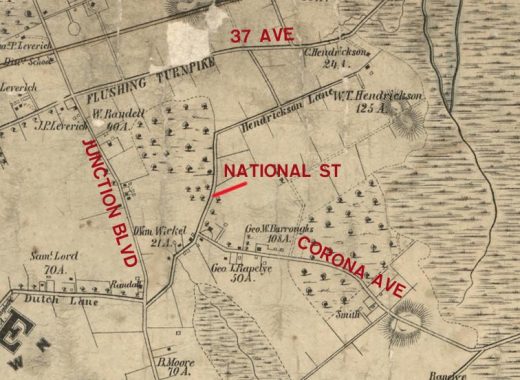
Here’s n excerpt from a Dripps map of Brooklyn and Queens from 1852. This was made before the racetrack was built, but the track was located just west of the road I have marked “National St.” Several roads that are heavily trafficked today were in existence, as dirt paths used by horses and wagons.
In 1871, developer Benjamin Hitchcock opened a Flushing and Northside Railroad station where the racecourse had been at what was by then called National Avenue, and by 1872, residents voted to change the name of West Flushing to Corona, Latin for “crown,” in an effort to mark it the king of Queens County towns and give the area a distinct identity.
National Street did, though, go through a few names before the present name was settled on; there was a stint as Grand Avenue, and in 1915, it was called Louona Street (see this map) at a time when all the streets in Corona bore names instead of numbers. “Louona” is a name that crops up relatively frequently in Corona, but I can’t find a derivation or namesake. By 1927 it seems that “National Street” had been settled on.
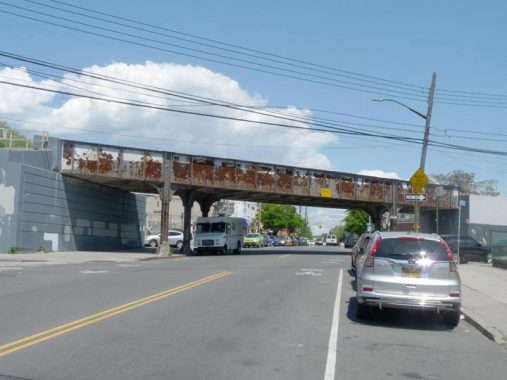
I recently walked National Street from its south end at Corona Avenue north to the 103rd-Corona Plaza station. The LIRR Port Washington branch runs through Corona west to east, accompanied by 45th Avenue on the south, 44th Avenue on the north. I am unsure when the line was placed on an embankment, creating grade separation but cutting off the north and south ends of Corona except at undefended crossings such as National Street. There used to be an LIRR Corona station just west of National Street that was eliminated in the 1930s and shows no trace today.
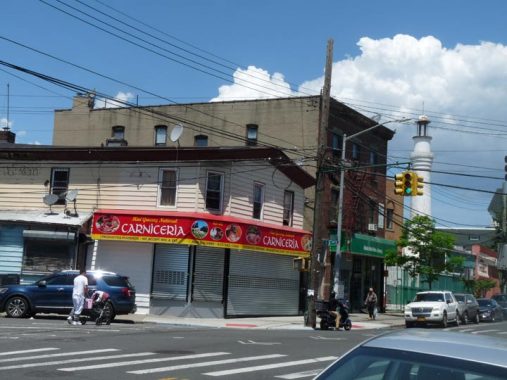
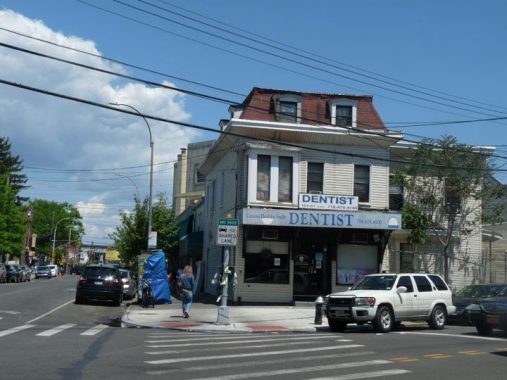
On 43rd Avenue on both sides of National we find some very old buildings that all the aluminum siding in the world can’t quite hide their true ages; a giveaway would be the slanted roof and dormer windows, hallmarks of “French Second Empire” construction quite popular on these shores in the 1870s and 1880s.
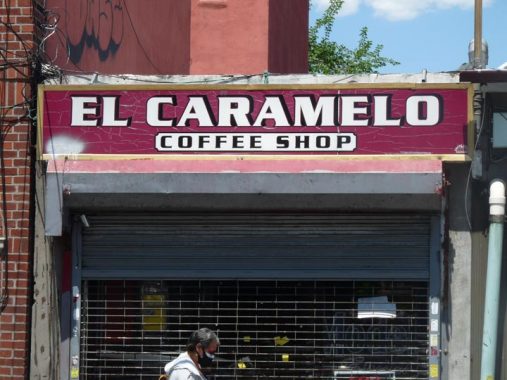
I liked this sign in bold maroon and subtly serifed lettering. Spanish is the main language in Corona, which boasts immigrants from several Central and South American countries, and is the go-to place in NYC for sampling cuisines from those countries both in restaurants along Roosevelt and 37th Avenues and also in trucks, food stands and pushcarts.
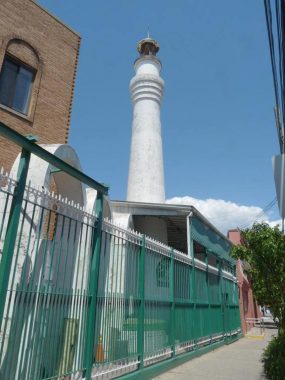
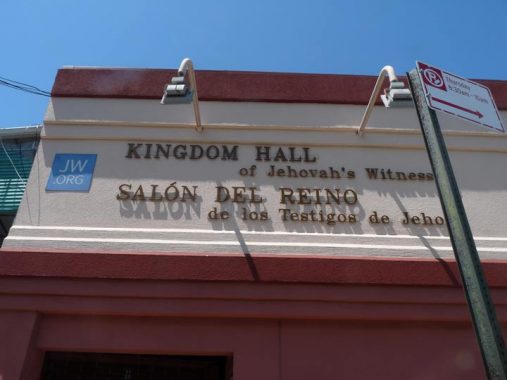
National is a short street, yet the faiths of several continents can be found along its few blocks. The minaret of the Masjid Alfalah dominates the view between 42nd and 43rd Avenues. As is true for a number of faiths, the website for the mosque is unhelpful regarding the building. In general, though, minarets, or prayer towers, seem to have first arrived in the Middle East in the 7th Century and were homages, or imitations, of church steeples in Syria, or Babylonian or Assyrian ziggurats that were still standing at the time. The oldest minaret in the world can be found in Tunisia at the Great Mosque of Kairouan, built in 836.
Right next door to the mosque can be found a Jehovah’s Witnesses Kingdom Hall.

Maurice Connolly (1881-1935) was Queens Borough President from 1911-1928, and made his home in Corona in this house on 42nd Avenue west of National Street for part of that time. Connolly was the youngest and longest serving Queens borough president but fell from power due to a major scandal.
His resignation as borough president in April 1928 occurred during an investigation of a sewer graft scandal. In October 1928 he was convicted of conspiracy to defraud the city, and was sentenced to one year in prison and fined $500. Following an unsuccessful appeal, he served the prison sentence in 1930-31.
The Union Evangelical Church, now the Dawn of Hope Church at National and 102nd Streets, was built in 1870 and was the first church in Corona. The land for the church was donated by Charles Leverich, a wealthy area landowner, who also became instrumental in the church’s success.
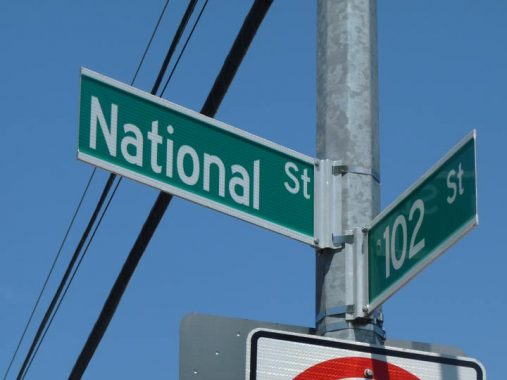
Though I like it that the Department of Transportation returned to Highway Gothic after several years with Clearview, I wish they would go back to all capitals on the signs. I’ve also complained that it uses the condensed version too much. Not so here in which the regular HWG is employed. I don’t think its a trend, though.
Surprisingly, National Street intersects only one north-south street, 102nd, creating an X-shaped intersection and two triangular plazas, Veterans Square and American Triangle. Both are rare shady areas on sun-drenched National Street, which gets rather hot during the warm months. The triangular sign was apparently placed by the Seventh-Day Adventist Church of Corona.
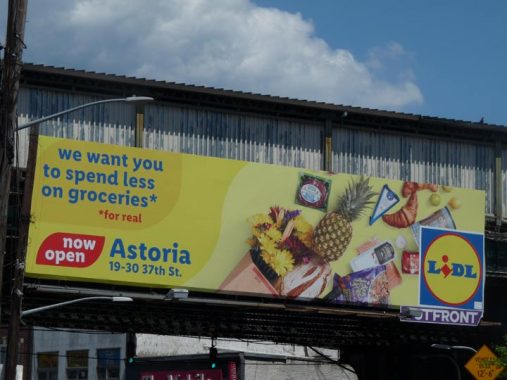
I had never heard of the grocery chain LIDL, but with good reason: the German-based company recently opened its first store on 37th Street near the Steinway piano factory in north Astoria. LIDL has a large billboard ad on the Roosevelt Avenue el. It’s apparently pronounced the same way the late Mets and Yankees pitcher Corey Lidle pronounced his name.
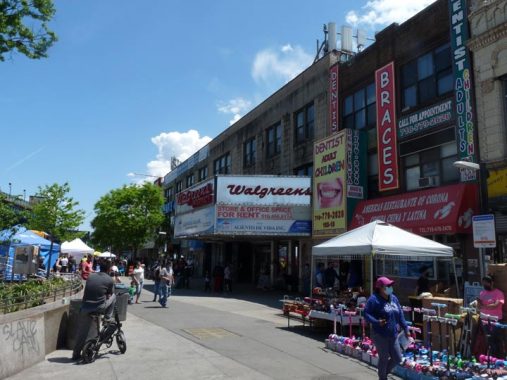
The Plaza at 103rd Street and Roosevelt Avenue , at the north end of National Street, was the only movie theater left in Corona. It was owned by Loew’s until 1952, when it became an independent movie house. Today, the auditorium floor is occupied by a Walgreen’s and other stores. The theater itself was open until 2005.
As always, “comment…as you see fit.” I earn a small payment when you click on any ad on the site.
5/26/21


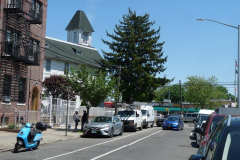
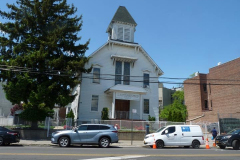
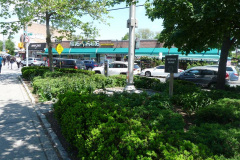
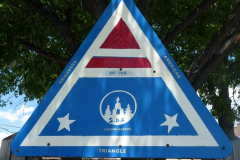
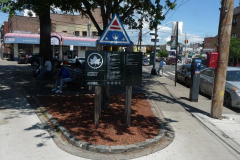
12 comments
The LIRR Station platform actually straddled National Street and included a freight elevator on 44th Ave.
The “Carniceria” store building served in numerous iterations during it’s history, existing as a pharmacy in the 1940 Census photos, and in my era as a Pfaff sewing machine repair shop. The building just north of it was one of several in the area to have served as a US Post Office.
The dormered home on the other corner was the Shloo family home and included a butcher shop run by Eddie Shloo into the early 1960s. Both the Shloo and Leverich names were prominent on older parcel maps of the neighborhood.
The Plaza Theatre was first owned by the Loews ( pronounced in Queens as “Lowees”) Corp. and later by Century Theatres. I saw hundreds of movies there in the 50s and 60s and it even hosted several early Rock and Roll stage shows to accompany Alan Freed films. Saturdays were given over to Kids Matinees featuring 20 cartoons, two features and giveaways. The theatre also gave out free dishes to all the ladies on Tuesday and Thurday evenings.
National Street had a small-town feel and seems to have retained it for the current residents. May that continue until the developers arrive!
Thanks again, Kevin. You do great work!
Hi Paul! Was thinking about you and
Vinny yesterday when I went bowling for my birthday, first time in years bowling. Remember when we were in that bowling league with Vinny’s brother in law? Hope you are doing well. I live in Santa Fe now.
Very interesting article, as usual. Two notes–Leverich Street in Jackson Heights must be from the same family. Lidl is opening a number of stores on Long island as well, in
former supermarkets left over by other store brands.
May I take the liberty of adding some information about the LIRR Port Washington Branch in Corona? The tracks were raised from grade level onto the current embankment in 1930, and a new elevated Corona Station was built at National Street as well. That station lasted until April 1964, when it closed about two weeks before the New York World’s Fair opened. LIRR service at Corona, for many years prior to the station closing, consisted of one train each way on weekdays only – westbound at about 7 AM and eastbound leaving Penn at about 4:30 PM. I have a 1961 LIRR employee timetable that shows those two trains – #413 westbound and #352 eastbound. The proximity of the #7 train after 1917 no doubt led to the evaporation of LIRR passenger demand at Corona.
It’s a very common misperception that Lidl and Aldi are somehow connected. They’re different trade names of the same company, one’s a spinoff of the other, something like that. In fact, other than both being from Germany they’re completely unrelated companies.
Aldi also owns Trader Joe’s, something that neither company publicizes. Aldi’s image as a cheap store for the lower end of the proletariat is completely at odds with Trader Joe’s hipster aura.
I can chime in as a native-born Queens resident, now living in Berlin, Germany regarding Aldi and Lidl. They both have the same concept, as being a discount supermarket. That is, reducing as many costs (and time) as possible, from buying in bulk from the suppliers, having an efficient logistics chain, placing the product directly on the shelves in the cardboard boxes they are shipped in instead of having them be taken out of the boxes and put on the shelves, have the customer bag their own items away from the cash register, and having a deposit system for the shopping carts. There are several other discount supermarkets in Germany, but these are the biggest two players.
Aldi was founded in 1954 by the Albrecht family brothers Theo and Karl (ALDI from ALbrecht and DIscounter), and split in 1961 into Aldi Nord [North] (run by Theo) and Aldi Süd [South] (run by Karl). Aldi has been in the USA since 1976 and is owned by Aldi Süd, where Trader Joe’s is owned by Aldi Nord since 1979. Lidl was founded in 1973 by Dieter Schwarz and has been in the US since 2017. The three riches people/families in Germany are 1. Beate Heister und Karl Albrecht Jr.- Aldi Süd; 2. Family of Theo Albrecht- Aldi Nord, Trader Joe’s, and 3. Dieter Schwarz – Schwarz-Group (Lidl, Kaufland super markets).
One thing to note is that the names are not possessive, so it’s ALDI and Lidl, not ALDI’s or Lidl’s (my little pet peeve).
One other amusing thing that I find especially the German Lidls (and occasionally Aldi) is their ethnic weeks and the assortment during “American Week” can be quite strange and funny. But that’s another story.
Schloo is the correct spelling of that family’s name, and the butcher shop was run by Charles Schloo.The Corona Theatre on Junction Boulevard was an alternate to the Plaza, and may actually have been in Elmhurst. It was converted to a bowling alley in its later days.I believe the Connolly home was moved from a location near Linden Park (now Park of the Americas) onto 42nd Avenue to accommodate developers.
I think that it was called National Street because it was next to now gone National Race Course as that old map shows, but I’m just guessing here and I could be wrong about that.
As the article says
In addition to the Loews Plaza, there was the Granada Theatre at 37th Ave and 101st Street, and the Palace Theatre on Northern Blvd and 100th Street. Both cinemas closed in the ‘50’s and were converted to alternate uses. The Granada building was demolished a while back, but the Palace remains in use as a church. Then there was also a Corona Theatre on Junction Blvd just a few storefronts up from Roosevelt Ave. believe this also closed in the ‘50’s. In the early 1970’s, when I was a child growing up just down Junction Blvd in neighboring Elmhurst, it was in use as a bingo parlor. The building still stands, being used for retail. Technically, all of the theaters I mentioned are in North Corona, though I seldom hear that distinction made when the area as a whole is referenced.
Very interesting indeed! As a teenager, being able to go to the Plaza Theater on a Sunday afternoon was a big deal for me in the late 60’s and very early 70’s❣️At the time, they were showing wonderful Spanish movies with Sarita Montiel, Sandro, Rafael de España, etc. and later on Polito Vega began offering shows with artists such as Roberto Monroig, La Lupe (who almost threw the piano off the stage), Daniel Santos, Johnny Ventura and many other artists. I have wonderful memories linked to the Plaza Theater❣️
the # place in the world to learn about and see old pictures posted by people from the community of Corona 11368 https://www.facebook.com/groups/CoronaWorld